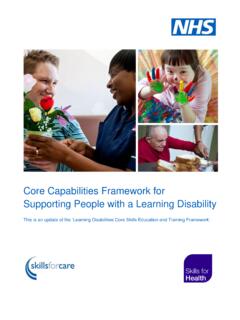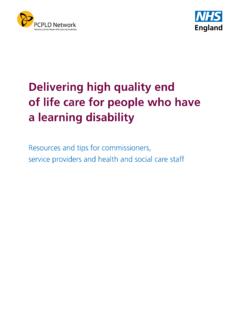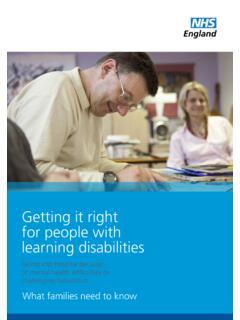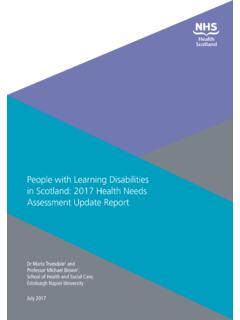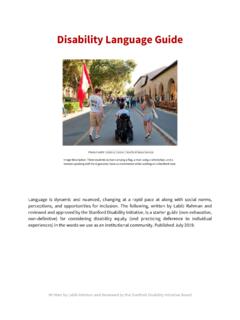Transcription of People with a learning disability, autism or both
1 People with a learning disability , autism or both Liaison and Diversion Managers and Practitioner resources (2019). NHS England and NHS Improvement Contents Equalities 2. Introduction .. 3. Background information .. 4. Identifying People with a learning disability or autism .. 7. The support needs of People with a learning disability or autism .. 10. Recommended 12. People 's stories .. 15. Key partners and stakeholders .. 16. Find out more .. 18. Publishing number: 000948. 1 | Contents Equalities Statement Promoting equality and addressing health inequalities are at the heart of our values. Throughout the development of the policies and processes cited in this document, we have : Given due regard to the need to eliminate discrimination, harassment and victimisation, to advance equality of opportunity, and to foster good relations between People who share a relevant protected characteristic (as cited under the Equality Act, 2010) and those who do not share it; and Given regard to the need to reduce inequalities between patients in access to, and outcomes from, healthcare services and to ensure services are provided in an integrated way where this might reduce health inequalities.
2 The protected characteristics covered by the Equality Act (2010) are: age, disability , gender reassignment, marriage and civil partnership (but only in respect of eliminating unlawful discrimination), pregnancy and maternity, race this includes ethnic or national origins, colour or nationality, religion or belief this includes lack of belief, sex, sexual orientation. Inclusion Health'/Health Inequalities has been used to define a number of groups of People who are not usually well provided for by healthcare services, and have poorer access, experiences and health outcomes. The definition covers People who are homeless and rough sleepers, vulnerable migrants (refugees and asylum seekers), sex workers, veterans and those from the Gypsy, Roma and Traveller communities. Liaison and Diversion services are expected to pay due regard to these groups when planning and delivery a service.
3 This includes the completion of Equality Impact Assessments regularly, with actions to ensure the service is addressing the needs of these cohorts. Page | 2. Introduction This practitioner guidance covers working with People with a known or suspected learning disability , autism or both. It includes useful information about working with this group of People , along with case studies, recommended actions and signposting to other resources and services. The Equality Act (2010) places a requirement on public services to anticipate and prevent discrimination against People with disabilities, which includes People with a learning disability , autism or both. Many People have support and communication needs that, if left unmet, will put them at a significant disadvantage when trying to navigate the youth or criminal justice system, making it less likely that a fair, just and appropriate outcome will be achieved.
4 learning disability and autism feature significantly in the NHS Long Term Plan1, which aims to improve peoples' health by making sure they receive timely and appropriate health checks, and also improve the level of awareness and understanding across the NHS of how best to support such People . Disproportionately higher numbers of children and adults with a learning disability enter the criminal justice system. People with a learning disability , autism or both are often not identified in police custody or at court. This can compromise both prosecution and a person's right to a fair trial. The joint inspection of the treatment of offenders with a learning disability in the criminal justice2 system revealed that the needs of People with a learning disability , autism or both were not being adequately addressed whilst they were in police and court settings.
5 Liaison and Diversion services are uniquely positioned to help resolve this situation. Services should have effective screening procedures and pathways in place so that People with a learning disability , autism or both are identified as soon as possible and their reasonable adjustments appropriate to their particular support needs are met. With the right support, People with a learning disability , autism or both can be held to account for their alleged offending and have access to justice, much in the same way as suspects without these conditions. There may be times, however, when diversion away from the criminal justice system is the most appropriate disposal route for a person. For example, when it is assessed that a person would not be able to cope in a custodial setting. (2019). 2A joint inspection of the treatment of offenders with learning disabilities in the criminal justice system, phase 1.
6 Arrest and sentence (HMIP, 2014). Page | 3. Background information Like anyone else, People with a learning disability , autism or both will have different life experiences, strengths, weaknesses and support needs. Many People will, however, share common characteristics, which, if left unsupported, might make them especially vulnerable. What is a learning disability ? a learning disability is a lifelong condition; it is not an illness and cannot be cured. The term learning disability is used in relation to People who have the following characteristics: A significantly reduced ability to understand complex information or learn new skills ( impaired intelligence'), A reduced ability to cope independently ( impaired social functioning'), and A condition which started before adulthood and has a lasting effect. Department of Health, (2001)3. Many People with a learning disability have greater health needs than the general population.
7 For example, they are more likely to experience mental ill health and are more prone to chronic health problems, epilepsy, physical and sensory disabilities. Many People with a learning disability will be unknown to learning disability or other social care services. The learning disability of those who come into contact with criminal justice services are likely to be classed as mild' or possibly moderate'. Sometimes People are described as having a borderline' learning disability , which means they are not eligible to access learning disability services but are likely to have similar support needs. Historically, certain Intelligence Quotient (IQ) scores have been used to indicate a mild', moderate' and severe' learning disability . The Royal College of Nursing guidance: Meeting the health needs of People with learning disabilities4 provides more details about this, as well as the health inequalities frequently experienced by this group of People .
8 Different terminology used The term learning disability is not to be confused with a learning difficulty which is used to refer to specific problems in processing information that substantially affects a person's ability to learn rather than the characteristics outlined in the above definition. However, some services or People may use the term learning difficulty incorrectly in reference to a learning 3 Valuing People : A new strategy for learning disability the 21st century (Department of Health, 2001). 4 Meeting the health needs of People with learning disabilities, (RCN, 2017). Page | 4. disability , so it is advisable to seek clarification. Some practitioners also use the internationally and diagnostically recognised term of intellectual disability to mean a learning disability . Labels can be de-humanising and it is important to remember that People with a learning disability are People first and all unique in their needs.
9 What is autism ? autism is a lifelong condition. It affects how a person communicates with, and relates to, other People and how they experience the world around them. A person will usually have had persistent difficulties with social communication and social interaction and restricted and repetitive patterns of behaviours, activities or interests since early childhood, to the extent that these limit and impair everyday Asperger's syndrome is considered to be on the continuum of the autism spectrum. People with Asperger's syndrome have the same difficulties described above but with no clinically significant delays in language, cognitive development or in the development of age- appropriate self-help skills, adaptive behaviour, and curiosity about the environment in childhood. Autistic spectrum conditions are not classed as a learning disability in themselves, however, approximately 20-30% of People with a learning disability also have autism6 and People with autism are more likely to experience mental health Prevalence In 2015, a report by the learning disability Observatory estimated that of the adult population of England had a learning Average estimates and research findings regarding the number of adults with a learning disability in the prison population vary between 1 10%, depending on the type of prison, the location and the research and screening methods used.
10 One research study9 compared assessments of prevalence of People with a learning disability using three different screening tools in a local prison, a women's prison, and a young offender institution. of the adult populations were found to have a learning disability , as defined by Valuing People , and were had a borderline' learning disability . 5 6 Emerson & Baines, (2010). 7 8 The learning disability Observatory's Main Report (2015). 9 Mottram and Lancaster, 2006; Mottram, (2007). Page | 5. Approximately 1% of the general population are identified as having an autistic spectrum condition, 2% of males and of However, the number of females with autism is thought to be under-diagnosed, as they are frequently missed or misdiagnosed, often because of misconceptions about females having autism11 and possibly due to women with autism presenting slightly differently to men.











